Jainism in the United States
Adherents of Jainism first arrived in the United States in the 20th century. Jain immigration began in earnest in the late 1960s and continues to the present day.
.jpg.webp) | |
| Total population | |
|---|---|
| 150,000,[1][2] | |
| Languages | |
| American English South Asia Languages | |
| Religion | |
| Jainism |
| Part of a series on |
| Jainism |
|---|
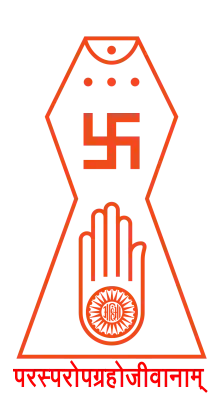 |
|
|
History
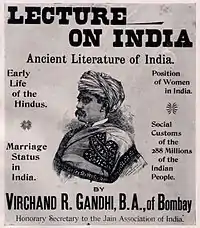
In 1893, Virachand Gandhi became the first Jain delegate to visit the United States, representing Jainism in the first ever Parliament of World Religions.[3] As the first practicing Jain to speak publicly in the United States on Jainism, he is a key figure in the history of American Jainism.[1] The first St. Louis Jain temple in the United States was built for the St. Louis World's Fair in 1904. After the fair, the temple moved to Las Vegas and later to Los Angeles. It is now owned by the Jain Center of Southern California. Adherents of Jainism first arrived in the United States in 1944.[4] Jain immigration began in earnest in the late 1960s after the passage of the Immigration Act of 1965. The United States has since become a center of the Jain diaspora.[5]
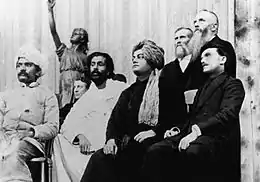
The first former Jain monastic to travel to the United States, Chitrabhanu, arrived in 1971. He gave several lectures about Jainism at Harvard University and established a Jain center in New York City. The first monk who traveled outside India by use of mechanical means was Acharya Sushil Kumar who arrived in the United States in 1975.[6] He established multiple Jain centers, including International Mahavira Jain Mission popularly known as Siddhachalam.[7] In the 1980s, he and Chitrabhanu inspired the founding of Federation of Jain Associations in North America to support the Jain community in the United States and Canada.[7]
As of 2010 the United States contained the most Jain temples of any country in the Jain diaspora.[1] At least one third of the Jains living outside India live in the United States, numbering close to 150,000.[1][2] Jain temples in the United States, which numbered 26 as of 2006, frequently incorporate marble and arches in a style reminiscent of Rajasthan architecture.[1] There are almost 100 distinct Jain congregations in the United States.[7]
Many Jains in the United States are professionals.[8] They also frequently volunteer at animal welfare organizations.[1]
Jain sects
According to The Pluralism Project at Harvard University, "Most American Jains agree that the sectarian streams of Jainism that have been significant in India for 2,000 years are fast losing their currency in 20th century America...The sectarian divisions of the Jain tradition have been left behind as Jain Americans concentrate on the difficult task of appropriating the tradition in a new environment." As noted below, many Jain temples in the United States contain images from both the Digambara and Śvētāmbara traditions. Jain conventions and gatherings in America feature teachings from both sects.[9][10]
Federation of Jain Associations in North America and Siddhachalam
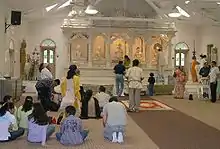
The Federation of Jain Associations in North America is an umbrella organization of local American and Canadian Jain congregations to preserve, practice, and promote Jainism and the Jain way of life.[11] Siddhachalam[12] in New Jersey is the first pilgrimage site for Jains outside India, bringing together all Jains in one place for worship, study and reflection.[13]
Jain symbols
The Federation of Jain Associations in North America uses a modified version of the standard Jain symbol, the Jain emblem. It replaces the swastika with an om because the former is not considered a pious symbol in the western world.[14]
Jain studies
Florida International University hosts the Bhagwan Mahavir Professorship in Jain Studies, the first Jain Studies chair at a North American university. In 2016, the Jain Society and Rice University signed a memorandum of understanding to establish a post-doctoral fellowship in Jain studies.[15]
American Jain centers
Category:Jain temples in the United States
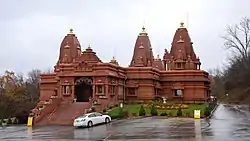
The Jain Center of America was the first Jain center in the United States. It opened in New York City in 1966. Since then, over 100 Jain centers and temples have opened in America.[16] Most Jain centers are complexes that include a main temple housing Digambara and Śvētāmbara images, libraries, meeting rooms, guest rooms, and so forth.
Arizona
California
- Jain Center of Northern California[17]
- Jain Center of Southern California
- Jain Center of Greater Sacramento[18]
- Jain Society of San Diego[19]
- Jain Center Of Los Angeles[20]
Colorado
- Jain Samaj of Colorado,[21] Denver
Connecticut
- Jain Center of Connecticut[22]
Florida
Illinois
- Jain Society of Metro Chicago[29]
Indiana
- Jain Center of Central Indiana[30]
Kansas
- Kansas City Jain Sangh[31]
Louisiana
- Jain Center of Northwest Louisiana[32]
Maryland
- Jain Society of Metro Washington[33]
Massachusetts
Minnesota
- Jain Center of Minnesota[38]
Missouri
- Jain Center of Greater St. Louis[39]
Nevada
- Jain Center of Las Vegas[40]
New Jersey
- Jain Center of New Jersey[41]
- Jain Sangh of Atlantic City - NJ[42]
- The Jain Sangh Inc. NJ (Cherry Hill Jain Sangh)[43]
- Jain Vishwa Bharti,[44] Iselin, New Jersey
- Siddhachalam, New Jersey
New York
Ohio
Oklahoma
- Tulsa Jain Sangh[56]
Pennsylvania
Tennessee
- Jain Society of Middle Tennessee[61]
Texas
- Jain Society of Houston[62]
- Jain Society of N. Texas/Dallas[63]
- Jain Sangh of Greater Austin TX[64]
- Siddhayatan
Washington
Wisconsin
- Jain Religion Center of Wisconsin[70]
Gallery

 Greater Baltimore Jain Temple
Greater Baltimore Jain Temple Main shrine at Siddhachalam Jain center, New Jersey
Main shrine at Siddhachalam Jain center, New Jersey Jain Center of America in New York City with images of Tirthankaras.
Jain Center of America in New York City with images of Tirthankaras..jpg.webp) Manastambha at Jain Center of Greater Phoenix (JCGP)
Manastambha at Jain Center of Greater Phoenix (JCGP).png.webp) Rishabhantha idol at Jain Center of Greater Phoenix (JCGP)
Rishabhantha idol at Jain Center of Greater Phoenix (JCGP).png.webp) Lord Mahaviraswami idol at Jain Center of Greater Phoenix (JCGP)
Lord Mahaviraswami idol at Jain Center of Greater Phoenix (JCGP) Lord Adinatha at Franklin Township derasar
Lord Adinatha at Franklin Township derasar Main vedi at Franklin Township derasar
Main vedi at Franklin Township derasar
 Namokar Mantra at Terapanti shrine of Franklin Township Derasar
Namokar Mantra at Terapanti shrine of Franklin Township Derasar
References
- Lee, Jonathan H. X. (21 December 2010), Encyclopedia of Asian American Folklore and Folklife, ABC-CLIO, pp. 487–488, ISBN 978-0-313-35066-5
- Wiley, Kristi L. (2004), Historical dictionary of Jainism, Scarecrow Press, p. 19, ISBN 978-0-8108-5051-4
- Jain, Pankaz; Pankaz Hingarh; Dr. Bipin Doshi, Priti Shah. "Virchand Gandhi, A Gandhi Before Gandhi". A german e-magazine. herenow4u.
- Watts, Tim J. "Religion, Indian American". In Huping Ling; Allan W. Austin (17 March 2015). Asian American History and Culture: An Encyclopedia. Routledge. p. 353. ISBN 978-1-317-47645-0.
- https://pluralism.org/jain-immigration
- The Gurus of India, Uban, SS., Allied Publishers, 1977. https://books.google.com/books?id=8dvGJjBHXYsC&pg=PA79&lpg=PA79&dq=Jain+monk+travel+sushil&source=bl&ots=b-vEc78VI7&sig=zZRiP56zp0UOKYyS33teEGPNsag&hl=en&sa=X&ved=0ahUKEwix-4jYh7HVAhXDWT4KHSdNAG8Q6AEIYTAP#v=onepage&q=Jain%20monk%20travel%20sushil&f=false
- Queen, Edward L.; Prothero, Stephen R.; Shattuck, Gardiner H. (2009), Encyclopedia of American religious history, Infobase Publishing, p. 531, ISBN 978-0-8160-6660-5
- https://pluralism.org/jain-immigration
- https://www.parmarth.org/pujya-sadhviji-gives-keynote-at-closing-of-the-jaina-convention/
- https://pluralism.org/unity-the-american-context
- "About JAINA". Retrieved 16 January 2012.
- Siddhachalam
- "About Siddhachalam". Siddhachalam. 28 June 2013. Retrieved 26 October 2017.
- "Jain Symbols". p. 29. Retrieved 16 March 2012.
- "US' Rice University to offer post-doctoral fellowship in Jain studies", The Economic Times, 25 January 2016
- https://pluralism.org/building-temples-and-networks
- http://jcnc.org/
- https://jaincenter.org/
- http://www.jssd.org/
- http://www.jaincenterofla.org/
- https://www.jainsamajofcolorado.org/
- https://www.jaincenterofconnecticut.org/
- https://www.jainsocietytampabay.org/
- http://www.jsocf.org/
- http://www.jaincentersfl.org/
- http://www.jaxjaintemple.org/
- http://www.augustahts.org/index.html
- http://www.jsgatemple.org
- http://www.jsmconline.org/
- https://www.htci.org/
- https://www.htccofkc.org/
- https://www.jaina.org/page/JainCenters
- https://jsmw.org/
- http://jsne.org/
- http://jcgb.org
- http://www.jsgd.org/
- http://lansingtemple.org/lansingtemple/
- https://jaincentermn.org/
- https://jcstl.org/
- https://www.hindutemplelv.org/
- http://www.jaincenternj.org/
- http://www.achindutemple.org/
- https://www.jainsangh.org/
- http://jvbnewjersey.org
- https://hcswny.net/
- http://www.hindusamajtemple.com/
- https://www.hindutemplealbany.org/temple/our-deities/
- http://www.jainsamajofli.org/
- https://jaintempleny.org/
- https://www.jaincenterus.org/
- https://www.hsnconline.org/
- http://jaincentercolumbus.org/
- https://www.jccinday.com/
- http://www.jsgc.org
- https://www.hindutempleoftoledo.org/
- https://tulsajainsangh.org/
- https://www.hindutemple-lehighvalley.org/
- https://www.haritemple.org/
- http://www.hindujaintemple.org/
- https://www.samarpantemple.org/
- https://www.jaina.org/page/TNMiddleTNJC/TN---Jain-Society-of-Middle-Tennessee.htm
- https://www.jainsocietyhouston.org/
- https://www.dfwjains.org/
- http://austinjainsangh.org/
- https://rvajaincenter.org/
- http://jaintempleva.org/
- https://sites.google.com/view/redmondjainderasar/home
- http://jainsocietyofseattle.org
- http://www.jcows.org/
- http://www.jainwi.org/
Further reading
- Jainism in America Bhuvanendra Kumar. Benaras, Jain Humanities Press, 1996
- The Western Order of Jainism by Nathubhai Shah of London (Jain Journal Vol XXX1, No 1 July 1996)
- Jains and Their Religion in America: A Social Survey by Dr. Bhuvannendra Kumar (Jain Journal Vol XXX1, No 1 July 1996)
- JAIN eLibrary attempts to provide an increasingly complete digitized collection of Jain Scriptures, dictionaries, encyclopedias, articles, commentaries, photographs, and other materials related to Jain life.